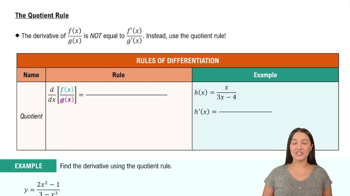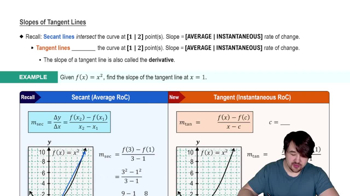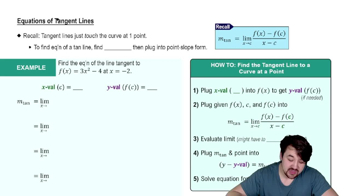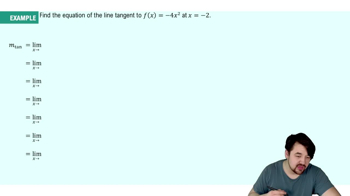Table of contents
- 0. Functions7h 52m
- Introduction to Functions16m
- Piecewise Functions10m
- Properties of Functions9m
- Common Functions1h 8m
- Transformations5m
- Combining Functions27m
- Exponent rules32m
- Exponential Functions28m
- Logarithmic Functions24m
- Properties of Logarithms34m
- Exponential & Logarithmic Equations35m
- Introduction to Trigonometric Functions38m
- Graphs of Trigonometric Functions44m
- Trigonometric Identities47m
- Inverse Trigonometric Functions48m
- 1. Limits and Continuity2h 2m
- 2. Intro to Derivatives1h 33m
- 3. Techniques of Differentiation3h 18m
- 4. Applications of Derivatives2h 38m
- 5. Graphical Applications of Derivatives6h 2m
- 6. Derivatives of Inverse, Exponential, & Logarithmic Functions2h 37m
- 7. Antiderivatives & Indefinite Integrals1h 26m
- 8. Definite Integrals4h 44m
- 9. Graphical Applications of Integrals2h 27m
- 10. Physics Applications of Integrals 2h 22m
2. Intro to Derivatives
Tangent Lines and Derivatives
Problem 1.1.98
Textbook Question
Simplify the difference quotients ƒ(x+h) - ƒ(x) / h and ƒ(x) - ƒ(a) / (x-a) by rationalizing the numerator.
ƒ(x) = √(1-2x)
 Verified step by step guidance
Verified step by step guidance1
First, identify the function given: \( f(x) = \sqrt{1-2x} \). We need to simplify the difference quotients \( \frac{f(x+h) - f(x)}{h} \) and \( \frac{f(x) - f(a)}{x-a} \).
For the first difference quotient \( \frac{f(x+h) - f(x)}{h} \), substitute \( f(x+h) = \sqrt{1-2(x+h)} = \sqrt{1-2x-2h} \). The expression becomes \( \frac{\sqrt{1-2x-2h} - \sqrt{1-2x}}{h} \).
To rationalize the numerator, multiply the numerator and the denominator by the conjugate of the numerator: \( \frac{\sqrt{1-2x-2h} - \sqrt{1-2x}}{h} \times \frac{\sqrt{1-2x-2h} + \sqrt{1-2x}}{\sqrt{1-2x-2h} + \sqrt{1-2x}} \).
Simplify the numerator using the difference of squares: \( (\sqrt{1-2x-2h})^2 - (\sqrt{1-2x})^2 = (1-2x-2h) - (1-2x) = -2h \). The expression becomes \( \frac{-2h}{h(\sqrt{1-2x-2h} + \sqrt{1-2x})} \).
Cancel \( h \) in the numerator and denominator: \( \frac{-2}{\sqrt{1-2x-2h} + \sqrt{1-2x}} \). This is the simplified form of the first difference quotient. Repeat a similar process for the second difference quotient \( \frac{f(x) - f(a)}{x-a} \) by substituting \( f(a) = \sqrt{1-2a} \) and rationalizing the numerator.
 Verified video answer for a similar problem:
Verified video answer for a similar problem:This video solution was recommended by our tutors as helpful for the problem above
Video duration:
11mPlay a video:
Was this helpful?
Key Concepts
Here are the essential concepts you must grasp in order to answer the question correctly.
Difference Quotient
The difference quotient is a fundamental concept in calculus that represents the average rate of change of a function over an interval. It is expressed as (ƒ(x+h) - ƒ(x)) / h, where h is the change in x. This concept is crucial for understanding derivatives, as the limit of the difference quotient as h approaches zero gives the derivative of the function.
Recommended video:

The Quotient Rule
Rationalizing the Numerator
Rationalizing the numerator involves manipulating an expression to eliminate any irrational numbers from the numerator. This is often done by multiplying the numerator and denominator by the conjugate of the numerator. This technique simplifies expressions, making it easier to evaluate limits or perform algebraic operations, especially in calculus.
Recommended video:

Finding Limits Numerically and Graphically
Function Composition
Function composition is the process of applying one function to the results of another function. In the context of the given question, understanding how to evaluate ƒ(x+h) involves substituting (x+h) into the function ƒ(x) = √(1-2x). This concept is essential for simplifying expressions and understanding how changes in input affect the output of a function.
Recommended video:

Evaluate Composite Functions - Special Cases

 5:13m
5:13mWatch next
Master Slopes of Tangent Lines with a bite sized video explanation from Nick
Start learningRelated Videos
Related Practice




